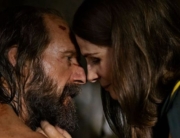When a museum’s artwork is so White and pressure mounts for diversity and inclusion, what’s an all-White staff to do? Sarah Vos’s White Balls on Walls poses this question with a documentary revealing the behind-the-scenes deliberations of Amsterdam’s Stedelijk Museum to bring diversity and inclusion to the premier art space. The title is a lift from the 1980s art provocateur group the Guerilla Girls, who derisively described default museum inventory as so much White-guy fapping. White Balls could use a little of the Girls’ irreverence. For a film about shaking things up, it’s a pretty straitlaced affair.
That may not be filmmaker Vos’s fault. Museum director Rein Wolfs is the model of professional decorum. The team supporting him is intelligent, committed, and careful what they say. When Wolfs announces that Job One for his team is to rethink the museum’s all-White collections (and mindset—even the gallery’s offices shine dazzling white), the women staff look mildly interested and the men a little more threatened. But no one protests. Conversely, no one expresses excitement at a rare chance to step back and approach the organization’s mission in a whole new way. Diplomatic, considered, fair: This is the right approach to rethink a cultural space. Exciting cinema it ain’t.
Like many such recent shifts, the demand for change does not come about spontaneously but bureaucratically: A cultural official stops into the office, casually dropping the news that funding will be cut if the Stedelijk doesn’t up its diversity game within four years. After this prompting, Wolfs immediately sets about acquiring work from artists of color. He considers outsourcing art from Suriname, one of the Netherlands’s former colonies. “I have to admit, I’ve almost only made exhibits with all White artists,” he discloses. “Some people would call it systematic racism, which I can imagine.”
Wolfs makes two hires to break the ice. He engages a Black artist and curator, Charl Landvreugd, who adopts the same cool, slightly distanced mien of his White colleagues. At one point, Landvreugd’s reserve drops when he recounts reactions to one of his own works, a portrait of a Black man. “Everyone liked it. Everyone thought it was beautiful. People even tried it at home for a while, and everyone thought it was creepy, which was all the more reason for me to keep making everything Black.” This revelation makes the museum’s mission feel less intellectualized and more real and complex, a suggestion that diversity inspires visceral reactions often glossed over by earnest discussions.Another new staff member promises to stir the pot some more. Artist Vincent van Vels had written to the museum an accusatory letter, declaring that artists of color had been “chronically underrepresented and excluded for years.” Wolfs brings van Vels on staff to the nervous laughter of his team, but we never see this potential game changer follow through on any reform or even criticism of the Stedelijk. After suggesting a looming confrontation, the hire is a bit of a letdown.Different scenes cover the museum’s openness agenda in piecemeal fashion, showing off the new nonbinary restrooms and a sad little underground prayer room for the Muslim staff. A section on artists Emil Nolde and Ernst Ludwig Kirchner brings up the question of cultural appropriation without really tackling what that charged term means. “I love and I hate that we are asking these questions,” intones Wolfs about the gallery’s shift in focus. And yes, it is important to ask them. Within the rarefied and refined walls of the Stedelijk, though, they somehow don’t seem as urgent or as engaging as they should be.

















Leave A Comment